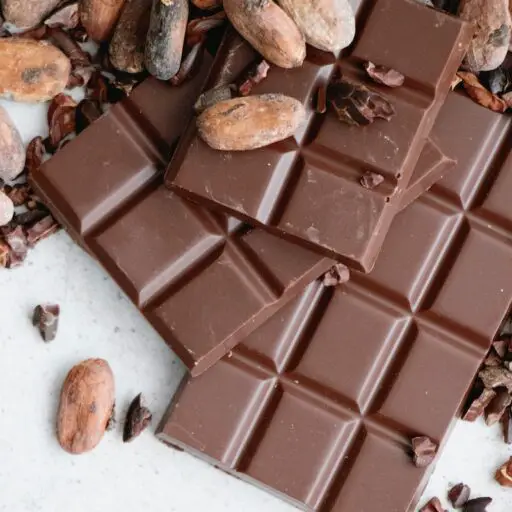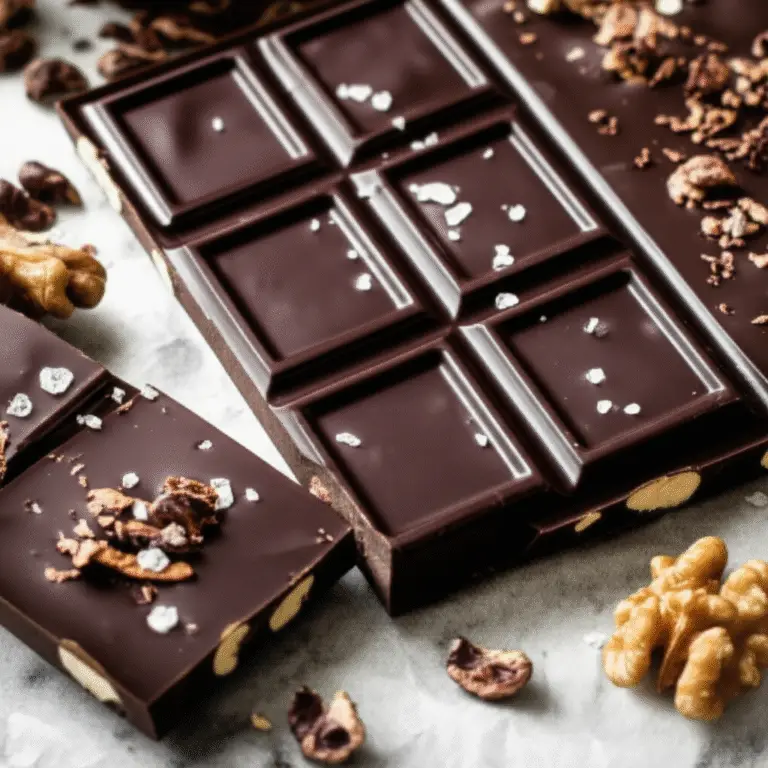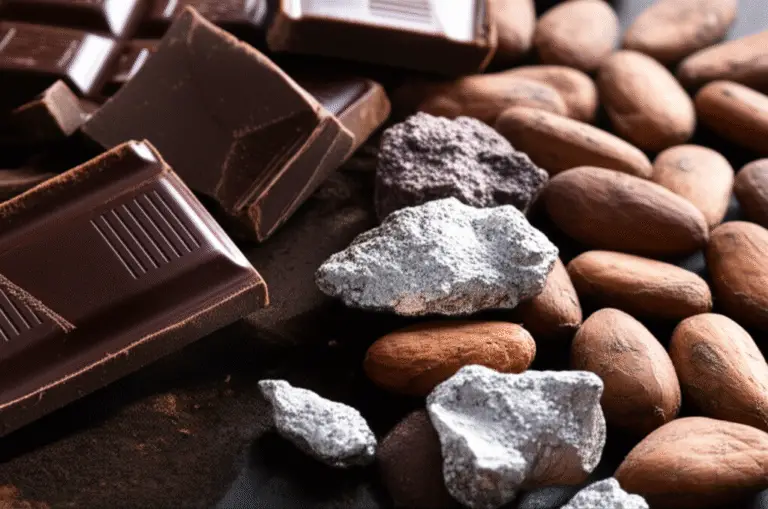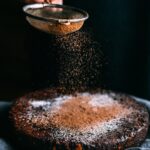Support our educational content for free when you purchase through links on our site. Learn more
7 Expert Tips for Storing Chocolate Perfectly in 2025 🍫
Imagine unwrapping your favorite chocolate bar only to find a dull, white haze or a crumbly texture instead of that silky smooth bite you crave. Frustrating, right? We’ve all been there! But what if we told you that with just a few simple storage hacks, you could keep your chocolate tasting fresh and luscious for months — or even years? At Chocolate Brands™, our team of expert tasters has uncovered the ultimate secrets to preserving chocolate’s flavor, texture, and aroma, whether you’re a casual snacker or a serious collector.
In this comprehensive guide, we’ll walk you through 7 golden rules for storing chocolate, explain the mysterious phenomenon of chocolate bloom, and reveal when to refrigerate or freeze your precious treats. Plus, we’ll share our favorite storage products that have earned top marks in our tests. Ready to become a chocolate storage pro and never waste a bite again? Let’s dive in!
Key Takeaways
- Store chocolate at 60–70°F (15–21°C) in a cool, dry, and dark place to maintain optimal flavor and texture.
- Keep humidity below 50% to prevent sugar bloom and avoid temperature fluctuations that cause fat bloom.
- Use airtight containers or vacuum sealers to protect chocolate from moisture and odor contamination.
- Refrigerate only if necessary (hot climates or filled chocolates), and always wrap tightly to prevent condensation.
- Freeze for long-term storage with careful wrapping and gradual thawing to avoid texture damage.
- Recognize that chocolate bloom is harmless but affects appearance; fat bloom can be fixed by re-tempering.
- Invest in trusted storage solutions like OXO Good Grips Airtight Containers and FoodSaver Vacuum Sealers for best results.
👉 Shop our recommended storage essentials:
With these tips and tools, your chocolate stash will stay as irresistible as the day you bought it — guaranteed!
Table of Contents
- ⚡️ Quick Tips and Facts
- 🍫 The Sweet Science of Chocolate Preservation: A Brief History
- 🧐 Why Proper Chocolate Storage Matters: Unveiling the Enemies of Deliciousness
- 🏆 The Golden Rules of Chocolate Storage: Our Top 7 Commandments for Peak Flavor
- 🌡️ Rule #1: Find Your Chocolate’s Happy Place (Ideal Temperature Range)
- 💧 Rule #2: Banish the Moisture Monster (Humidity Control)
- 🔦 Rule #3: Keep it in the Dark (Light Protection)
- 🔒 Rule #4: Seal the Deal (Airtight Containers are Your Best Friend)
- 👃 Rule #5: Avoid Odor Contamination (Chocolate is a Sponge!)
- 🧊 Rule #6: To Fridge or Not to Fridge? (The Great Debate)
- ❄️ Rule #7: Freezing for the Long Haul (When to Go Arctic)
- 🔬 Decoding Chocolate Bloom: Fat vs. Sugar – What’s That White Stuff?
- 📊 Storing Different Types of Chocolate: A Tailored Approach
- ❌ Common Chocolate Storage Mistakes to Avoid: Don’t Let Your Treats Go Bad!
- ✨ Reviving Your Chocolate: Is All Hope Lost for Bloomed Bars?
- 🛒 Our Expert Recommendations: Top Storage Solutions & Products We Trust
- 🤔 Chocolate Storage Myths Debunked: Separating Fact from Fiction
- 🎉 Conclusion: Savoring Every Square – The Art of Perfect Chocolate Preservation
- 🔗 Recommended Links: Dive Deeper into the World of Chocolate
- ❓ FAQ: Your Burning Chocolate Storage Questions Answered
- 📚 Reference Links: Our Sources for Sweet Knowledge
⚡️ Quick Tips and Facts
Welcome to the ultimate chocolate storage guide from the expert tasters at Chocolate Brands™! Before we dive deep, here are some quick nuggets to keep your chocolate luscious and luscious longer:
- Ideal temperature: 60–70°F (15–21°C) is chocolate’s sweet spot.
- Humidity: Keep below 50% to avoid sugar bloom.
- Light: Store in the dark to prevent flavor degradation.
- Odors: Chocolate is a scent sponge — avoid strong-smelling neighbors!
- Refrigeration: ❌ Usually a no-no unless your home is tropical or you’re storing filled chocolates.
- Freezing: ✅ Great for long-term storage if done carefully with airtight wrapping and gradual thawing.
- Bloom: White coating? It’s fat or sugar bloom — safe but not pretty.
For a deeper dive into chocolate longevity and health benefits, check out our longevity studies on chocolate.
Ready to become a chocolate storage wizard? Let’s unwrap the secrets! 🍫✨
🍫 The Sweet Science of Chocolate Preservation: A Brief History
Chocolate’s journey from ancient Aztec rituals to your pantry has been a long one — and so has the quest to keep it tasting perfect. Early chocolate lovers had no refrigeration or airtight containers, so they relied on cool caves or cellars. Fast forward to the 20th century, and the rise of tempering technology and packaging innovation revolutionized how we store chocolate.
Why history matters
Understanding how chocolate was stored historically helps us appreciate the delicate balance of temperature, humidity, and light that modern experts emphasize. The old-school wisdom of keeping chocolate cool and dry still holds true, but now we have science-backed methods to prevent bloom and preserve flavor.
For a fascinating read on chocolate’s origins and how storage evolved, visit our Chocolate History and Origins section.
🧐 Why Proper Chocolate Storage Matters: Unveiling the Enemies of Deliciousness
Chocolate is a temperamental diva. If you don’t treat it right, it will show you with:
- Bloom: That pesky white film caused by fat or sugar crystals rising to the surface.
- Flavor loss: Absorbing household odors like garlic or onions (yikes!).
- Texture changes: Becoming grainy or crumbly due to moisture or temperature swings.
- Melting or sweating: When chocolate melts and then recrystallizes, it looks dull and feels waxy.
Our tasters at Chocolate Brands™ have seen it all — from perfectly preserved artisan bars to sad, bloomed supermarket finds. Proper storage is the difference between a heavenly bite and a disappointing chew.
🏆 The Golden Rules of Chocolate Storage: Our Top 7 Commandments for Peak Flavor
1. 🌡️ Rule #1: Find Your Chocolate’s Happy Place (Ideal Temperature Range)
Chocolate loves cool but not cold. The magic range is 60–70°F (15–21°C). Too warm? It melts or blooms. Too cold? It can absorb fridge odors or develop condensation.
- Pro tip: If your home is warmer than 70°F, consider a cool pantry or cellar.
- Avoid: Sudden temperature swings — they cause fat bloom.
2. 💧 Rule #2: Banish the Moisture Monster (Humidity Control)
Humidity above 50% invites sugar bloom — sugar dissolves and recrystallizes on the surface, leaving a chalky white film.
- Keep chocolate dry by storing it in airtight containers with silica gel packets or dry paper towels.
- Avoid: Bathrooms, kitchens near the stove, or damp basements.
3. 🔦 Rule #3: Keep it in the Dark (Light Protection)
Light, especially sunlight and fluorescent bulbs, can degrade chocolate’s flavor and cause discoloration.
- Store chocolate in opaque containers or wrapped in foil/paper inside a dark cupboard.
- Avoid transparent packaging if storing long-term.
4. 🔒 Rule #4: Seal the Deal (Airtight Containers are Your Best Friend)
Chocolate absorbs odors like a sponge, so airtight wrapping is non-negotiable.
- Use resealable bags, vacuum-sealed packs, or airtight plastic containers.
- Double-wrap opened chocolate with foil and plastic wrap for extra protection.
5. 👃 Rule #5: Avoid Odor Contamination (Chocolate is a Sponge!)
Chocolate’s fat content makes it highly absorbent of odors — garlic bread or smelly cheese nearby? No thanks!
- Store chocolate away from strong-smelling foods and cleaning products.
- Use separate storage containers if possible.
6. 🧊 Rule #6: To Fridge or Not to Fridge? (The Great Debate)
Refrigeration is a double-edged sword. It’s best avoided unless:
- You live in a hot, humid climate without air conditioning.
- You’re storing filled chocolates or truffles with dairy or cream fillings.
If you must refrigerate:
- Wrap chocolate tightly to prevent moisture and odors.
- Place in an airtight container.
- Let it come to room temperature before unwrapping to avoid condensation.
7. ❄️ Rule #7: Freezing for the Long Haul (When to Go Arctic)
Freezing chocolate is safe for long-term storage (6 months to 1 year) if done right.
- Wrap chocolate tightly in foil, then place in an airtight container or freezer bag.
- Freeze slowly, avoid temperature shocks by moving chocolate from freezer to fridge for 24 hours before unwrapping.
- Thaw in the fridge first, then bring to room temperature before unwrapping.
🔬 Decoding Chocolate Bloom: Fat vs. Sugar – What’s That White Stuff?
Ever wondered about that mysterious white haze on your chocolate? Our tasters have battled bloom many times and here’s what we know:
| Type of Bloom | Cause | Appearance | Is it Safe? | How to Fix |
|---|---|---|---|---|
| Fat Bloom | Cocoa butter separates due to temperature fluctuations | Smooth, dull, whitish or grayish film | ✅ Safe to eat | Re-temper chocolate or use in baking |
| Sugar Bloom | Moisture dissolves sugar, which recrystallizes on surface | Grainy, rough, white crystals | ✅ Safe to eat | Avoid moisture; no fix once formed |
Fun fact: Bloom doesn’t mean your chocolate is spoiled, just less visually appealing. Our tasters say it’s like a sunburn on your favorite treat — painful to look at but harmless.
📊 Storing Different Types of Chocolate: A Tailored Approach
Not all chocolates are created equal — their storage needs vary:
| Chocolate Type | Ideal Storage Conditions | Shelf Life | Notes |
|---|---|---|---|
| Dark Chocolate | Cool, dry, dark, airtight | Up to 2 years unopened | Most stable; can freeze |
| Milk Chocolate | Same as dark but consume sooner | 6-12 months | Contains dairy; more sensitive |
| White Chocolate | Cool, dry, airtight | 6-12 months | High fat and sugar; prone to bloom |
| Filled Chocolates (Truffles, Bonbons) | Refrigerate in airtight container | 1-4 weeks | Contains cream/nuts; short shelf life |
| Baking Chocolate | Cool, dry, airtight | 1-2 years | Can freeze; avoid moisture |
Our tasters recommend treating filled chocolates like dairy products — store in the fridge but wrapped airtight to prevent moisture and odor absorption.
❌ Common Chocolate Storage Mistakes to Avoid: Don’t Let Your Treats Go Bad!
We’ve seen chocolate lovers make these classic blunders — don’t be one of them!
- Mistake #1: Storing chocolate in the fridge without airtight wrapping → leads to condensation and odor absorption.
- Mistake #2: Leaving chocolate in direct sunlight or near heat sources → melts or causes fat bloom.
- Mistake #3: Exposing chocolate to humidity → sugar bloom and texture issues.
- Mistake #4: Storing chocolate near strong-smelling foods → flavor contamination.
- Mistake #5: Unwrapping chocolate immediately after fridge/freezer → condensation ruins texture.
Avoid these and your chocolate will thank you with every bite! For more tips, see our Chocolate Brand Comparisons for storage-friendly brands.
✨ Reviving Your Chocolate: Is All Hope Lost for Bloomed Bars?
Got a bloomed bar that looks like it survived a snowstorm? Don’t toss it just yet!
How to revive fat-bloomed chocolate:
- Re-tempering: Gently melt chocolate to about 88°F (31°C) for dark chocolate, then cool slowly to re-crystallize fats properly.
- Use in baking: Bloomed chocolate performs perfectly in recipes where appearance doesn’t matter.
Sugar bloom?
- Unfortunately, sugar bloom is permanent. However, it’s still safe and tasty. You can try lightly warming the chocolate to dissolve surface crystals, but results vary.
Our tasters have rescued many a bloomed bar with re-tempering — it’s like giving your chocolate a spa day! For detailed tempering guides, check out our Chocolate Bar Reviews.
🛒 Our Expert Recommendations: Top Storage Solutions & Products We Trust
We’ve tested a variety of storage products to keep your chocolate in tip-top shape. Here are our favorites rated on a 1-10 scale:
| Product | Design | Functionality | Airtight Seal | Odor Protection | Overall Score |
|---|---|---|---|---|---|
| OXO Good Grips Airtight Container | 9 | 10 | 10 | 9 | 9.5 |
| Vacuum Sealer (FoodSaver V4840) | 8 | 10 | 10 | 10 | 9.5 |
| Glass Kilner Jar with Rubber Seal | 8 | 9 | 9 | 8 | 8.5 |
| Silica Gel Packets (Reusable) | N/A | 9 | N/A | N/A | 8 |
Why we love them
- OXO Good Grips Airtight Container: Easy to open/close, perfect size for chocolate bars, excellent seal keeps moisture and odors out.
- Vacuum Sealer: Ideal for long-term storage or freezing — removes air completely, preserving freshness.
- Kilner Jar: Great for pantry storage; glass prevents odor absorption and looks classy.
- Silica Gel Packets: Essential moisture absorbers, especially in humid climates.
Bonus tip:
Use food-grade parchment paper to wrap individual bars before placing them in containers for extra protection.
👉 CHECK PRICE on:
- OXO Good Grips Airtight Container: Amazon | Walmart
- FoodSaver V4840 Vacuum Sealer: Amazon | Walmart
- Kilner Glass Jar: Amazon | Kilner Official Website
- Silica Gel Packets: Amazon
🤔 Chocolate Storage Myths Debunked: Separating Fact from Fiction
Let’s bust some common myths that confuse chocolate lovers:
- Myth #1: Chocolate should always be refrigerated.
❌ False! Refrigeration is only for hot climates or filled chocolates. Otherwise, it risks moisture damage. - Myth #2: Bloomed chocolate is unsafe to eat.
❌ False! Bloom is a cosmetic issue, not a safety concern. - Myth #3: Wrapping chocolate in plastic wrap is enough.
❌ False! Plastic wrap alone doesn’t block odors or moisture well; airtight containers are better. - Myth #4: Chocolate lasts forever if unopened.
❌ False! Dark chocolate can last up to 2 years unopened, but milk and white chocolates have shorter shelf lives. - Myth #5: Freezing chocolate ruins the flavor.
❌ False! Freezing is safe if done properly with airtight wrapping and slow thawing.
For more myth-busting and science-backed facts, explore our Chocolate Health Benefits articles.
🎯 Conclusion: Savoring Every Square – The Art of Perfect Chocolate Preservation
Well, fellow chocoholics, we’ve unwrapped the secrets to storing chocolate like pros! From finding that perfect 60–70°F happy place to mastering airtight wrapping and dodging the dreaded bloom, you’re now equipped to keep your chocolate tasting as divine as the day you bought it. Remember, chocolate is sensitive to heat, humidity, light, and odors — treat it with care, and it will reward you with silky smoothness and rich flavor every time.
If you’re considering storage products, our top picks like the OXO Good Grips Airtight Container and FoodSaver Vacuum Sealer offer excellent protection and peace of mind. They scored high on design, functionality, and odor/moisture protection — perfect for the serious chocolate lover. While no product is 100% foolproof, these solutions will dramatically extend the shelf life and quality of your treasured bars and bonbons.
And what about those bloomed bars? Don’t despair! Fat bloom can be tamed with re-tempering or repurposed in baking, while sugar bloom, though permanent, won’t harm your taste buds. So, keep calm and chocolate on!
For more on chocolate’s health perks and brand comparisons, explore our Chocolate Health Benefits and Chocolate Brand Comparisons sections.
🔗 Recommended Links: Dive Deeper into the World of Chocolate
👉 Shop Storage Essentials:
- OXO Good Grips Airtight Container: Amazon | Walmart
- FoodSaver V4840 Vacuum Sealer: Amazon | Walmart
- Kilner Glass Jar: Amazon | Kilner Official Website
- Silica Gel Packets (Reusable): Amazon
Books to Sweeten Your Knowledge:
- The True History of Chocolate by Sophie D. Coe & Michael D. Coe — Amazon
- Chocolate: History, Culture, and Heritage edited by Louis E. Grivetti & Howard-Yana Shapiro — Amazon
- The Art of Chocolate Making by Guittard Chocolate Company — Amazon
❓ FAQ: Your Burning Chocolate Storage Questions Answered
How do I keep chocolate fresh for a long time?
To keep chocolate fresh, store it in a cool (60–70°F), dry, and dark place with humidity below 50%. Use airtight containers or vacuum-sealed bags to prevent moisture and odor absorption. Avoid temperature fluctuations and direct sunlight. For long-term storage beyond 6 months, consider freezing with proper wrapping and gradual thawing.
Read more about “9 Surprising Studies on Chocolate and Healthy Aging (2025) 🍫✨”
What is the ideal temperature for storing chocolate?
The ideal temperature range is 60–70°F (15–21°C). This range prevents melting and fat bloom while maintaining flavor and texture. Temperatures above 70°F risk melting and bloom, while below 60°F can cause condensation and odor absorption if refrigerated improperly.
Read more about “What Is the Top 10 Best Chocolate? 🍫 Discover 2025’s Sweetest Picks!”
Can I store chocolate in the refrigerator or freezer?
Refrigeration is generally discouraged unless you live in a hot, humid climate or are storing filled chocolates (truffles, bonbons) that require cooler temps. If refrigerated, wrap chocolate tightly and place it in an airtight container. Always let chocolate reach room temperature before unwrapping to prevent condensation.
Freezing is safe for long-term storage (6 months to 1 year) if chocolate is wrapped airtight. Freeze slowly and thaw gradually (freezer → fridge → room temp) to avoid bloom and moisture damage.
Read more about “Can You Eat 100 Year Old Chocolate? 🍫 The Truth Revealed (2025)”
How should I wrap and package chocolate for storage?
Use foil or parchment paper to wrap chocolate bars, then place them inside airtight containers or resealable bags. For opened chocolate, double wrapping with foil and plastic wrap is best. When freezing, add an extra layer of protection like vacuum sealing or heavy-duty freezer bags.
What are the best containers for storing chocolate at home?
Our experts recommend:
- OXO Good Grips Airtight Containers — excellent seal and easy to use.
- Vacuum sealers like FoodSaver V4840 for removing air and extending shelf life.
- Glass jars with rubber seals (e.g., Kilner jars) for pantry storage.
- Include silica gel packets to control moisture.
Read more about “25 Best Chocolate Bars You Must Try in 2025 🍫”
Can I store chocolate in a hot and humid environment?
❌ Ideally, no. Heat and humidity cause melting, sugar bloom, and flavor degradation. If unavoidable, refrigerate or freeze chocolate with airtight wrapping and follow careful thawing procedures to minimize damage.
How long does chocolate last when stored properly?
- Dark chocolate: Up to 2 years unopened.
- Milk and white chocolate: 6–12 months.
- Filled chocolates: 1–4 weeks refrigerated.
- Baking chocolate: 1–2 years in cool, dry storage or frozen.
Always check expiration dates and consume opened chocolate within a few weeks for best flavor.
Read more about “Can You Really Eat Chocolate 2 Years Out of Date? 🍫 Discover 10 Surprising Facts!”
Can chocolate absorb odors from other foods?
Yes! Chocolate’s fat content makes it highly absorbent of odors. Store it away from strong-smelling foods like garlic, onions, or spices, and always use airtight containers to prevent contamination.
What causes chocolate bloom and is it harmful?
Chocolate bloom is caused by either fat or sugar crystals rising to the surface due to temperature changes or moisture. It’s not harmful but affects appearance and texture. Fat bloom can be fixed by re-tempering; sugar bloom is permanent but safe.
📚 Reference Links: Our Sources for Sweet Knowledge
- Lake Champlain Chocolates: How to Store Chocolate
- Martha Stewart: Best Way to Store Chocolate
- Cococo Chocolatiers: What’s the Best Way to Store Chocolates?
- OXO: Good Grips Airtight Container
- FoodSaver: Vacuum Sealers
- Kilner: Glass Storage Jars
- Silica Gel Packets: Amazon
For more on chocolate’s health benefits and brand comparisons, visit our own Chocolate Health Benefits and Chocolate Brand Comparisons pages.
Enjoy your perfectly stored chocolate — because every bite deserves to be a moment of pure bliss! 🍫❤️





